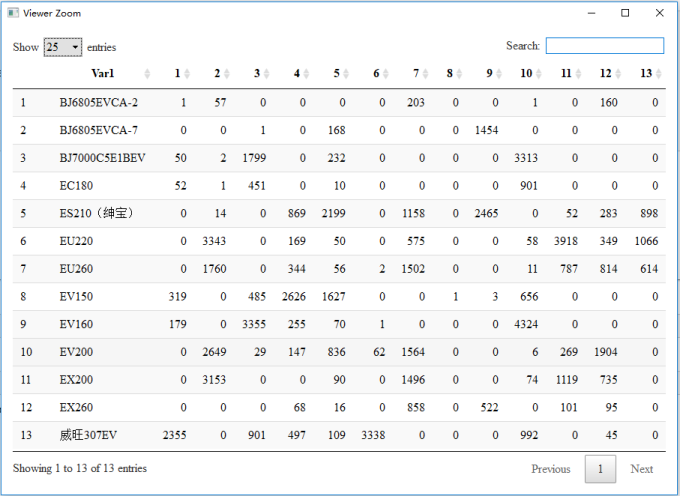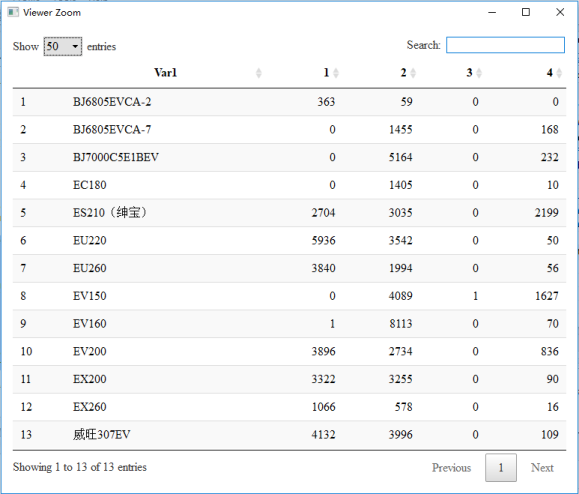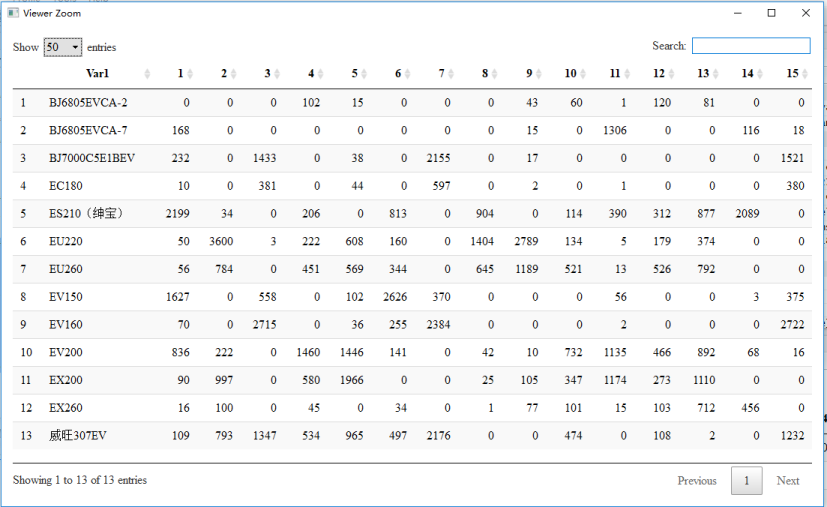ML: 聚类算法R包-对比
测试验证环境
数据: 7w+ 条,数据结构如下图:
> head(car.train)
DV DC RV RC SOC HV LV HT LT Type TypeName
1 379 85.09 0.00 0.0 62.99 3.99 0.00 12 0 10f689e8-e6cc-47a3-be5a-dbc3833428ef EV200
2 379 85.09 370.89 59.9 63.99 4.01 0.00 12 0 10f689e8-e6cc-47a3-be5a-dbc3833428ef EV200
3 379 85.09 0.00 0.0 64.99 4.01 0.00 12 0 10f689e8-e6cc-47a3-be5a-dbc3833428ef EV200
4 379 85.09 0.00 0.0 66.00 4.03 1.55 12 11 10f689e8-e6cc-47a3-be5a-dbc3833428ef EV200
5 379 85.09 0.00 0.0 67.00 4.03 0.00 12 0 10f689e8-e6cc-47a3-be5a-dbc3833428ef EV200
6 379 85.09 0.00 0.0 68.00 4.05 0.00 13 0 10f689e8-e6cc-47a3-be5a-dbc3833428ef EV200
机器配置:

R version:
> version
_
platform x86_64-w64-mingw32
arch x86_64
os mingw32
system x86_64, mingw32
status
major 3
minor 2.5
year 2016
month 04
day 14
svn rev 70478
language R
version.string R version 3.2.5 (2016-04-14)
nickname Very, Very Secure Dishes
R包性能对比
全局函数及参数设置
##----------------------全局设置-------------------------------
remove(list=ls())
space_path <- c("E:\\RScore\\kmeans\\")
setwd(space_path)
Sys.setlocale(category = "LC_ALL",local="chinese") ##table 行列转换函数
tblView <- function (tbl)
{
##install.packages("tidyr")
library(tidyr)
df <- as.data.frame(tbl)
df <- spread(data = df, key = Var2, value = Freq)
datatable(df)
} ## 公共函数:数据读写及计算
source("core.R",encoding="utf-8")
teld.ml.init() ##训练样本
car.train <- teld.ml.rQuery("D_Cluster")
newdata <- car.train[1:8]
stats::kmeans
source code:
> ################################################stats::kmeans######################################
> startTime <- Sys.time();
>
> library(stats)
> kc <- kmeans(x=newdata, centers = 13)
> #plot(newdata[,c("DV","DC")],col=kc$cluster)
> tbl <- table(car.train$TypeName,kc$cluster)
> tblView(tbl)
>
> ##耗时间
> endTime <- Sys.time()
> difTime <- difftime(endTime,startTime,units = "secs")
> print(paste0("stats::kmeans total time:", difTime))
[1] "stats::kmeans total time:0.195545196533203"
stats::kmeans total time:0.195545196533203, result view:

fpc::kmeansruns
source code:
> ################################################fpc::kmeansruns######################################
> startTime <- Sys.time();
>
> library(fpc)
> kc1 <- kmeansruns(data = newdata,krange = 1:15,critout = TRUE)
2 clusters 9394.437
3 clusters 185919.7
4 clusters 482630.4
5 clusters 414875.3
6 clusters 376338
7 clusters 334493.6
8 clusters 303976.7
9 clusters 279036.3
10 clusters 432009.9
11 clusters 363074.8
12 clusters 405784.7
13 clusters 397422.8
14 clusters 371842.5
15 clusters 408561.7
Warning messages:
1: Quick-TRANSfer stage steps exceeded maximum (= 3507150)
2: Quick-TRANSfer stage steps exceeded maximum (= 3507150)
3: Quick-TRANSfer stage steps exceeded maximum (= 3507150)
> tbl<- table(car.train$TypeName,kc1$cluster)
> tblView(tbl)
>
> ##耗时间
> endTime <- Sys.time()
> difTime <- difftime(endTime,startTime,units = "secs")
> print(paste0("fpc::kmeansruns total time:", difTime))
[1] "fpc::kmeansruns total time:107.454074859619"
[1] "fpc::kmeansruns total time:107.454074859619" result view:

cluster::pam
source code
> ################################################cluster::pam######################################
>
> library(cluster)
> cPam <- pam(x=newdata,k=13)
Error in pam(x = newdata, k = 13) :
have 70143 observations, but not more than 65536 are allowed
Error: 待确认
fpc::pamk
source code
> ################################################fpc::pamk######################################
>
> library(fpc)
> fPamk <- pamk(newdata,krang=1:15)
Error in pam(sdata, k, diss = diss, ...) :
have 70143 observations, but not more than 65536 are allowed
Error: 待确认
stats::hclust
source code:
################################################fpc::pamk######################################
>
> library(fpc)
> fPamk <- pamk(newdata,krang=1:15)
Error in pam(sdata, k, diss = diss, ...) :
have 70143 observations, but not more than 65536 are allowe
Error: 待确认
mclust::Mclust
source code:
> ################################################mclust::Mclust######################################
> library(mclust)
> EM<-Mclust(newdata)
Error in hcVVV(data = c(379, 379, 379, 379, 379, 379, 379, 379, 379, 379, :
NAs in foreign function call (arg 13)
In addition: Warning message:
In hcVVV(data = c(379, 379, 379, 379, 379, 379, 379, 379, 379, 379, :
NAs introduced by coercion to integer range
Error: 待确认
cluster::fanny
source code:
> ################################################cluster::fanny######################################
> library(cluster)
> fannyz=fanny(newdata,13,metric="SqEuclidean")
Error in fanny(newdata, 13, metric = "SqEuclidean") :
long vectors (argument 5) are not supported in .Fortran
Error: 待确认
e1071::cmeans
source code:
> ################################################e1071::cmeans######################################
> startTime <- Sys.time();
>
> library("e1071")
> eCm<-cmeans(newdata,15)
> tbl <- table(car.train$TypeName,eCm$cluster)
> tblView(tbl)
>
> ##耗时间
> endTime <- Sys.time()
> difTime <- difftime(endTime,startTime,units = "secs")
> print(paste0("stats::kmeans total time:", difTime))
[1] "stats::kmeans total time:8.7237401008606"
[1] "stats::kmeans total time:8.7237401008606" result view:

待验证
ML: 聚类算法R包-对比的更多相关文章
- ML: 聚类算法R包 - 模型聚类
模型聚类 mclust::Mclust RWeka::Cobweb mclust::Mclust EM算法也称为期望最大化算法,在是使用该算法聚类时,将数据集看作一个有隐形变量的概率模型,并实现模型最 ...
- ML: 聚类算法R包-层次聚类
层次聚类 stats::hclust stats::dist R使用dist()函数来计算距离,Usage: dist(x, method = "euclidean", di ...
- ML: 聚类算法R包-模糊聚类
1965年美国加州大学柏克莱分校的扎德教授第一次提出了'集合'的概念.经过十多年的发展,模糊集合理论渐渐被应用到各个实际应用方面.为克服非此即彼的分类缺点,出现了以模糊集合论为数学基础的聚类分析.用模 ...
- ML: 聚类算法R包-网格聚类
网格聚类算法 optpart::clique optpart::clique CLIQUE(Clustering In QUEst)是一种简单的基于网格的聚类方法,用于发现子空间中基于密度的簇.CLI ...
- ML: 聚类算法R包-K中心点聚类
K-medodis与K-means比较相似,但是K-medoids和K-means是有区别的,不一样的地方在于中心点的选取,在K-means中,我们将中心点取为当前cluster中所有数据点的平均值, ...
- ML: 聚类算法R包 - 密度聚类
密度聚类 fpc::dbscan fpc::dbscan DBSCAN核心思想:如果一个点,在距它Eps的范围内有不少于MinPts个点,则该点就是核心点.核心和它Eps范围内的邻居形成一个簇.在一个 ...
- ML: 聚类算法-K均值聚类
基于划分方法聚类算法R包: K-均值聚类(K-means) stats::kmeans().fpc::kmeansruns() K-中心点聚类(K-Medoids) ...
- ML: 聚类算法-概论
聚类分析是一种重要的人类行为,早在孩提时代,一个人就通过不断改进下意识中的聚类模式来学会如何区分猫狗.动物植物.目前在许多领域都得到了广泛的研究和成功的应用,如用于模式识别.数据分析.图像处理.市场研 ...
- 【转】利用python的KMeans和PCA包实现聚类算法
转自:https://www.cnblogs.com/yjd_hycf_space/p/7094005.html 题目: 通过给出的驾驶员行为数据(trip.csv),对驾驶员不同时段的驾驶类型进行聚 ...
随机推荐
- 模拟主库创建数据文件,dg备库空间不足时问题处理
本篇文档测试目的: 模拟实际环境中,主库对表空间添加数据文件,备库空间不足,最终导致MRP进程自动断开,处理方式. 1.问题环境模拟 1)正常情况下的dg 主库创建数据文件,备库接受日志,自动创建表空 ...
- JAVA基础部分复习(三、泛型)
JAVA泛型的基本使用: /** * JAVA泛型的使用 * 定义:泛型的本质是参数化类型,就是说所操作的数据类型被指定为一个参数. * * 定义泛型方法的规则 * 1.所有泛型方法声明都有一个类型参 ...
- 一些简单二分题,简单的hash,H(i),字符串题
说在前面: 题是乱七八糟的. 几个二分的题. (但是我的做法不一定是二分,有些裸暴力. 1. Equations HDU - 1496 输入a,b,c,d问你这个方程有多少解.a*x1^2+b*x2^ ...
- 20155219 2016-2017-2 《Java程序设计》第5周学习总结
20155219 2016-2017-2 <Java程序设计>第5周学习总结 教材学习内容总结 异常处理 语法与继承构架 异常就是程序在运行时出现的不正常情况.java中的错误以对象的方式 ...
- xdoj 1146 (逆向01背包)
背包 有:01背包 逆向背包 多重背包 完全背包 所有的背包都可以根据更新的方向一维实现 amazing?! #include <iostream> #include <cstd ...
- 重绘和回流(reflow和repaint)
由于DOM操作会导致浏览器的回流,回流需要花费大量的时间进行样式计算和节点重绘与渲染,所以应当尽量减少回流次数. 以下是几种常见的减少重绘和回流的方法: 一.不要一项一项的更改页面的样式,尽量一口气写 ...
- 04 jsp,EL,JSTL
jsp:Java Server Page 什么是jsp?从用户角度看待 ,就是是一个网页 , 从程序员角度看待 , 其实是一个java类, 它继承了servlet,所以可以直接说jsp 就是一个Se ...
- 1.Tensorflow的基本概念:
1.Tensorflow的基本概念: 1.使用图(graphs)来表示计算任务 2.在被称之为会话(Session)的上下文(context)中执行图 3.使用tensor表示数据 4.通过变量(Va ...
- 命令提示符操作及Java的特点
day1_3 命令提示符的操作 GUI 图形化方式(可视化) CLI 命令行方式 (编程方式) dir 列出当前目录下文件及文件夹 md 创建文件夹 rd 删除文件夹(只能删除空文件夹) cd 进入指 ...
- 《DSP using MATLAB》Problem 6.14
代码: %% ++++++++++++++++++++++++++++++++++++++++++++++++++++++++++++++++++++++++++++++++ %% Output In ...
